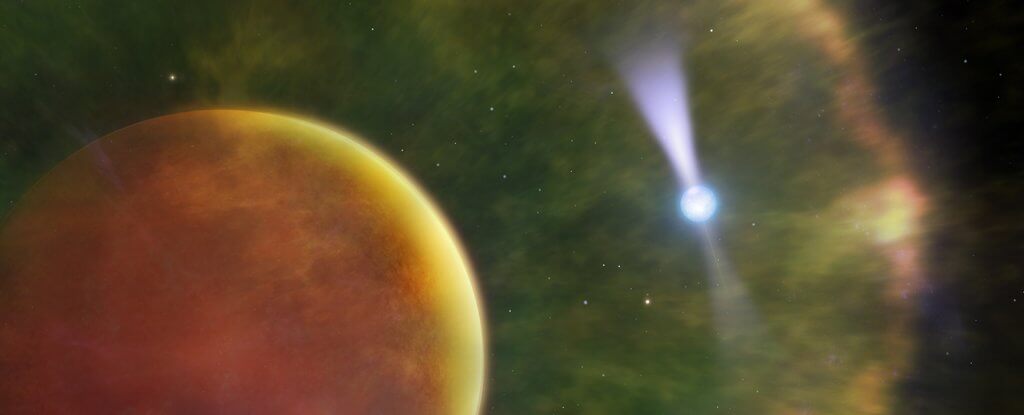
Observations of a pulsar in the constellation of the Arrow using the 305-meter radio telescope at Arecibo Observatory showed that the substance ejected stream of charged particles from the surface of the companion acts as a natural lens, greatly simplifying the astronomers the task of examining the source of radiation. The results of this latest study were presented in the journal Nature.
“High-resolution observations have become possible thanks to a rare geometry and characteristics of a pair of stars orbiting each other. Gas volatilized from the surface of a brown dwarf under “attacks” in the pulsar acts as a lens. This allowed us to explore areas of intense radiation located 20 kilometers from the pulsar and its magnetosphere with unprecedented precision,” says Robert Meyn, the study’s lead author from the University of Toronto (Canada).

The system of the pulsar the pulsar PSR B1957 + 20 in the representation of the artist
Almost all knowledge about the Universe we have acquired through telescopes that collect electromagnetic waves from astronomical objects. On its way to Earth, these waves can be distorted and absorbed, giving valuable information about the invisible material between the stars and galaxies.
Pulsars are a special type of neutron stars, remnants of exploded supernova, from the poles which are narrow beams of radio waves. Usually “baby” pulsars rotate very fast and gradually slow down, spending on the radiation energy. The pulsar generates beams of radio waves has long been known as excellent objects for probing interstellar matter. Therefore, they are often referred to as galactic lighthouses.
Surveillance of one millisecond pulsar PSR B1957 + 20, also known as Black widow, pointed out a surprising property of the mixture of ionized gas and namagnichennosti, which he beats with his companion, a brown dwarf.
The system is located 6,500 light years from Earth. Pulsar and brown dwarf separated by only 2 million miles, and one revolution around a common center of mass they make about 9 earth hours. Because of this proximity to the brown dwarf is always facing one side to the PSR B1957 + 20, the stream of charged particles which heats it up to 6000 degrees Celsius. In the end, the substance under the effect of radiation and wind escapes from the surface and forms a cloud of plasma, resembling a comet’s tail.

Illustration showing how the plasma cloud amplifies the signal of a pulsar
When beams of radio waves pass through the edge of the cloud, they become up to 80 times brighter at certain frequencies. The authors suggest that plasma tail acts as a lens, increasing the observed brightness of the pulsar for short periods of time.
The object PSR B1957 + 20 is interesting because it is probably the most massive pulsar known, and further research on the precise measurement of its mass will help to understand how matter behaves in extreme conditions and how massive may be a neutron star.
In addition to observations with incredibly high resolution the result of the study can be the key to the nature of the mysterious phenomena known as fast radio bursts (FRB).
“The impulses that we found in our study show considerable similarities with the bursts of one of the recurring FRB. We believe that many of the observed properties of FRB can be explained by the lensing plasma in their galaxies,” concluded Robert Maine.
The observation of the pulsar can bring scientists to unravel the mysteries of the FRB signals
Nikolai Khizhnyak